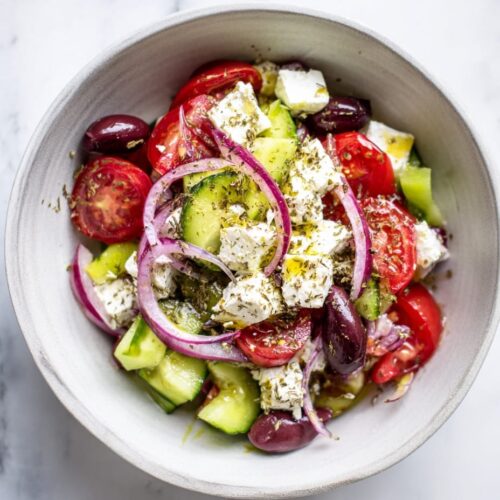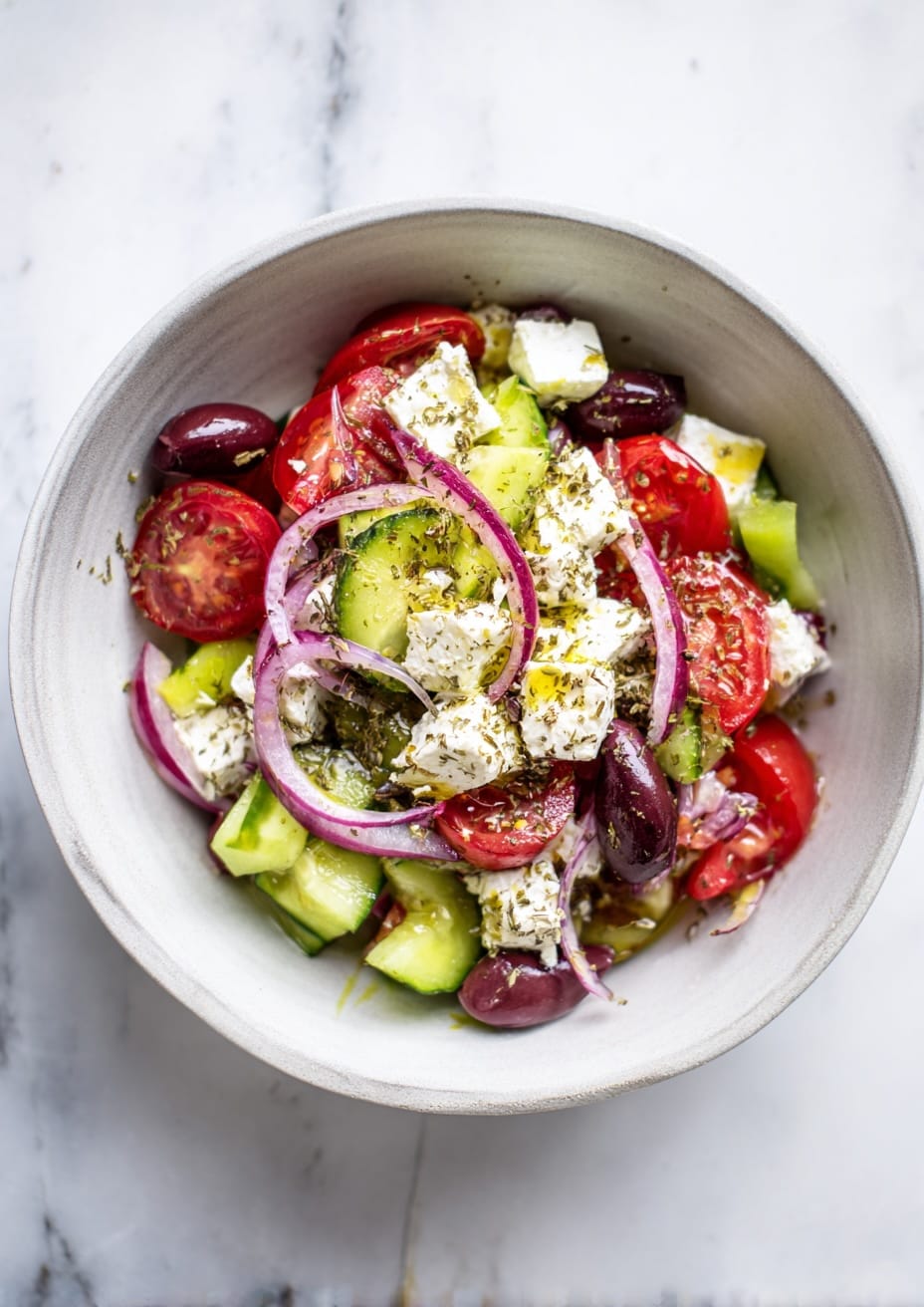The salad that defines simplicity
Every cook I know has a dish they fall back on when life feels too busy for anything elaborate. For me, it’s this classic greek salad with feta and oregano. It’s what I make when I crave something crisp, salty, and sun-drenched but I’m standing in our kitchen under a grey English sky. I learned that you don’t need much—just a few ripe tomatoes, cucumber, onion, and a block of feta that crumbles when kissed by olive oil.
When I first started making greek salads, I used to overthink everything. But this version taught me restraint. The secret lies in proportion, not complexity. The oregano gives that earthy sharpness that feta loves, while good olive oil binds it all together. When I want something more filling, I turn to a pasta salad with feta and kalamata olives or a couscous greek salad with feta and herbs.
The heart of the salad
This is the kind of dish that reminds you how far good ingredients can go. The tomatoes should be juicy enough to release a little sweetness into the dressing, the cucumber should snap when sliced, and the onion must be thin enough not to dominate. A drizzle of proper extra virgin olive oil brings everything to life, and the feta—crumbled roughly—adds that unmistakable salty punch. I sometimes serve it alongside grilled halloumi, though it’s glorious on its own with crusty bread.
If you like cooler flavours, the cucumber greek salad with feta and dill is wonderfully refreshing. Or, if you’re after something smoky, you might enjoy my grilled vegetable greek salad with feta. And if you’d like more ideas, you can see the full collection of greek salads with feta that I’ve tested and loved.
Ingredients (serves 4)
- 4 ripe medium tomatoes, cut into wedges
- 1 medium cucumber, peeled and sliced into half-moons
- 1 small red onion, thinly sliced
- 150 g feta cheese, cut into cubes or crumbled
- 12 kalamata olives, pitted
- 2 tbsp extra virgin olive oil
- 1 tbsp red wine vinegar
- ½ tsp dried oregano
- pinch of sea salt
- freshly ground black pepper
Ingredient notes
Use ripe tomatoes at room temperature so they release their juices naturally when salted. Cherry tomatoes also work beautifully if you prefer a sweeter note. Feta should be firm and briny—go for a greek PDO feta made from sheep’s milk if you can find it.

Olives are the heartbeat of this salad. Kalamata is traditional, but you can swap them for black or green olives if that’s what’s in your cupboard. Avoid olives packed in metallic-tasting brine—they dull the flavour.
Equipment needed
You’ll need a chopping board, a sharp knife, a medium serving bowl, and a small jar for shaking the dressing. I often use a wide shallow dish to build the salad so the feta sits visibly across the top—presentation matters with such a simple plate.
A fine-mesh strainer is handy if your feta is stored in brine; draining it helps avoid excess saltiness. I also recommend a sturdy wooden spoon for tossing, as metal utensils can tear the tomato skins.
Instructions
Slice the tomatoes and cucumber, then arrange them in a shallow bowl. Scatter the thinly sliced red onion and olives over the top. Combine olive oil, vinegar, oregano, salt, and pepper in a small jar and shake vigorously to emulsify. Pour the dressing over the vegetables, toss gently, and let the salad rest for ten minutes before adding the feta.
Feta should be added last so it doesn’t disintegrate into the dressing. Either crumble it gently over the top or cut into neat cubes for a more structured look. Serve immediately, or refrigerate for no longer than 30 minutes before serving to keep the vegetables crisp.
Cooking technique and recommendations
The key to texture lies in the resting stage. Those ten minutes allow the salt to draw out tomato juices, which mingle with the dressing to create a natural brine that’s both tangy and refreshing. If you skip it, the salad can taste a touch flat. For deeper flavour, warm the olive oil slightly before mixing—it’ll carry the aroma of oregano and soften the sharpness of the onion. Just be gentle; you’re coaxing flavour, not cooking.
What to serve with this recipe
This salad shines beside grilled lamb chops, roast chicken, or even flaky spanakopita. I often eat it with toasted pita brushed in garlic oil for a quick lunch. Its acidity balances anything fatty, making it perfect alongside baked aubergine or moussaka.
If you’re preparing a spread, pair it with a grilled vegetable greek salad or a couscous greek salad with feta and herbs for contrasting textures and colours. You can also browse all my favourite greek salads with feta if you fancy exploring more combinations.
Wine and beer pairings
A crisp Assyrtiko from Santorini is brilliant here—it cuts through the feta’s salt with a bright citrusy finish. A chilled sauvignon blanc with herbal notes also works well, echoing the oregano. If you prefer beer, a Helles lager balances the acidity while staying light and refreshing. A wheat beer adds a faint sweetness that plays nicely against the briny feta.
Frequently asked questions
Can i make this greek salad ahead of time?
You can prepare the vegetables a few hours ahead, but don’t add the dressing or feta until just before serving.
Is feta vegetarian?
Traditional feta uses animal rennet, but many British versions use vegetarian cultures—always check the label.
Can i use lemon juice instead of vinegar?
Yes, lemon juice gives a gentler acidity and a fresher lift, especially if you’re serving seafood.
How long does greek salad last in the fridge?
It’s best eaten fresh, but if stored in an airtight container, it’ll hold for about a day before softening.
What can i use instead of feta?
Try crumbly goat’s cheese for a milder taste, or marinated tofu for a vegan version.
Tips for success when making greek salad
Balance salt carefully. Olives and feta are already salty, so season with restraint. Taste after dressing rather than before—it’s the surest way to avoid overseasoning.
Give it time to rest. The salt and vinegar mellow the onion and release the tomato juices, giving that beautiful mix of tang and sweetness.
Recipe variation suggestions
Add sliced avocado for creaminess or roasted peppers for smokiness. A few capers also give a wonderful briny lift. If you’re after something more filling, mix in cooked quinoa or chickpeas. It becomes a full meal while keeping its freshness.
Storage and reheating greek salad
This salad isn’t meant to be reheated—it’s all about crisp, raw texture. Keep leftovers in the fridge for up to 24 hours in an airtight container. Drain any liquid before serving again, and if needed, crumble a little fresh feta on top to revive it.
Health benefits and dietary alternatives
This greek salad is rich in monounsaturated fats from olive oil, which support heart health. Feta provides calcium and protein, while cucumber and tomato bring hydration and antioxidants.
If you’re vegan, swap feta for almond-based cheese and use maple syrup in the dressing for balance. Gluten-free diners can enjoy it as-is—it’s naturally free from grains.

Classic Greek Salad with Feta and Oregano
Ingredients
- 4 Tomatoes ripe medium, cut into wedges
- 1 cucumber medium , peeled and sliced into half-moons
- 1 red onion small, thinly sliced
- 150 g feta cheese cut into cubes or crumbled
- 12 Kalamata olives pitted
- 2 tbsp olive oil extra virgin
- 1 tbsp red wine vinegar
- ½ tsp Oregano dried
- Pinch sea salt
- Black Pepper Freshly ground
Instructions
- Slice the tomatoes and cucumber, then arrange them in a shallow bowl. Scatter the thinly sliced red onion and olives over the top. Combine olive oil, vinegar, oregano, salt, and pepper in a small jar and shake vigorously to emulsify.
- Pour the dressing over the vegetables, toss gently, and let the salad rest for ten minutes before adding the feta.
- Feta should be added last so it doesn’t disintegrate into the dressing. Either crumble it gently over the top or cut into neat cubes for a more structured look. Serve immediately, or refrigerate for no longer than 30 minutes before serving to keep the vegetables crisp.

